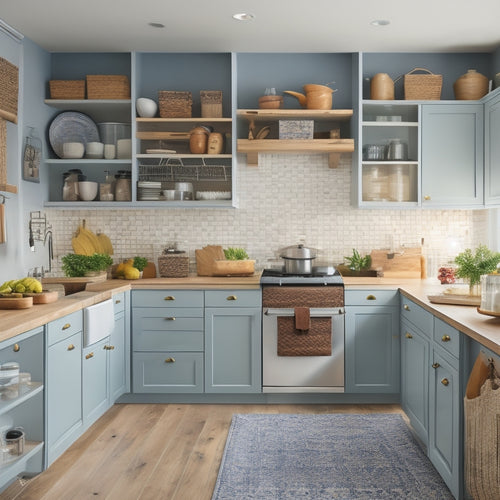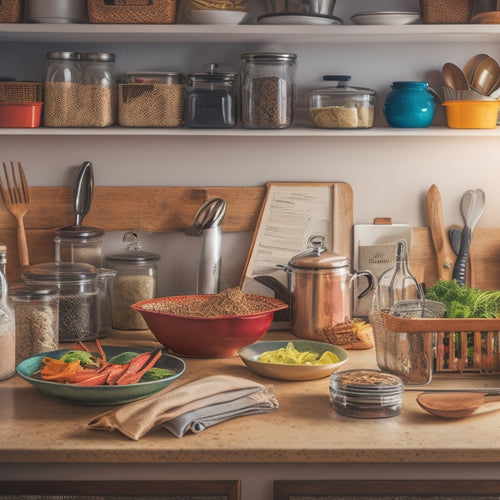
Declutter Your Small Kitchen With Online Guidance
Share
You're ready to transform your small kitchen into a clutter-free haven. Start by conducting a kitchen audit to categorize items and clear countertops. Then, identify clutter hotspots and search for online solutions to tackle them. Next, purge unwanted items through donation, recycling, or discarding. With a fresh slate, create a functional kitchen layout that maximizes vertical storage space and optimizes your workflow. Use online guidance to find storage solutions, like shelves and hanging baskets, that fit your kitchen's unique needs. As you implement these changes, you'll uncover even more ways to refine your kitchen's organization and efficiency.
Key Takeaways
• Conduct a kitchen audit to identify clutter hotspots and sort items into categories for efficient organization.
• Utilize online guidance to find clutter-free solutions and apply them to create a peaceful cooking space.
• Implement efficient utensil organization strategies, such as drawer dividers and hanging racks, to maximize storage.
• Establish a maintenance routine, including daily tidying and monthly deep cleaning, to maintain a clutter-free kitchen.
• Leverage hidden storage areas, like wall-mounted shelves and under-cabinet storage, to optimize vertical space in a small kitchen.
Start With a Kitchen Audit
Before you begin decluttering, take everything out of your kitchen cabinets, drawers, and shelves to get a clear view of what you have and where it's all hiding. This kitchen audit will help you identify what you need, what you can discard, and what you can donate or sell.
As you empty your cabinets, sort items into categories like baking supplies, cooking utensils, and dinnerware. This will give you a sense of what you have in each category and help you decide what to keep and what to let go of.
Next, clear your countertops to create a clean slate. Remove everything, including appliances, cookbooks, and decorative items. This will give you a sense of what you need to keep on your countertops and what can be stored away.
Organizing your cabinets and clearing your countertops are essential steps in decluttering your small kitchen. By doing so, you'll be able to see what you have, get rid of what you don't need, and create a more efficient and functional kitchen space.
Identify Clutter Hotspots Online
Search online for kitchen organization ideas and pay attention to the areas that consistently appear cluttered in photos and videos, as these common clutter hotspots will likely resonate with your own kitchen struggles. You'll probably notice that countertops, kitchen sink areas, and pantries are frequently overwhelmed with clutter.
Take note of these virtual organization inspiration points, as they'll help you identify the most critical areas to focus on in your own kitchen.
Next, analyze what's causing the clutter in these hotspots. Is it a lack of storage, poor layout, or simply too many items? Look for clutter-free solutions online that address these specific challenges. You might find ideas for installing shelves, using baskets, or implementing a 'zone' system to keep similar items together.
Make a mental (or written) note of the solutions that resonate with you, and consider how you can apply them to your own kitchen. By doing so, you'll be well on your way to creating a more organized, functional, and peaceful cooking space.
Purge Unwanted Kitchen Items
Now that you've identified the clutter hotspots in your kitchen, it's time to tackle the items that are contributing to the chaos, and start purging the ones that are no longer serving a purpose. Be ruthless – if you haven't used it in the past year, it's probably safe to get rid of it.
Start by gathering boxes and bags for donation and recycling. Donate appliances and cookware that are still in good condition but no longer needed. Consider dropping them off at local charity shops or thrift stores.
Next, sort through your containers and gadgets, and recycle anything that's broken, worn out, or outdated. Recycle containers made of plastic, glass, or cardboard, and recycle gadgets like old toasters or blenders. Don't forget to wipe down and clean items before donating or recycling them.
Create a Functional Kitchen Layout
Set up your kitchen zones by grouping similar activities, like food prep, cooking, and cleaning, to create a functional layout that flows smoothly and saves you time. This will help you navigate your kitchen efficiently and reduce clutter. Assign a specific area for each zone, considering the 'golden triangle' concept, where your sink, stove, and fridge form the three points. This layout optimizes movement between these high-traffic areas.
Next, incorporate storage solutions and space-saving ideas to keep your kitchen organized. Install shelves, hooks, or a pegboard to hang frequently used items, like pots, pans, and utensils. Invest in multi-functional furniture, such as a kitchen cart with built-in storage, to maximize floor space.
When it comes to decor, prioritize functional design. Choose a color scheme that complements your kitchen style, and add decorative elements that serve a purpose, like a utensil holder or a wall-mounted spice rack.
Maximize Vertical Storage Space
By thinking vertically, you can reveal hidden storage opportunities in your small kitchen, making the most of your walls and ceiling to keep frequently used items within easy reach.
Install wall-mounted shelves to store less-frequently used items like special occasion dishes or cookbooks. Hanging baskets can also be used to store fruits, vegetables, or spices, keeping them organized and visible.
Don't forget to utilize the space under your cabinets. Invest in under-cabinet storage solutions like slide-out drawers or shelves to store items like plates, bowls, or cleaning supplies. This will help keep your countertops clear and make the most of the often-wasted space.
Additionally, consider implementing a pantry organization system to maximize the storage capacity of your pantry. By using baskets, bins, and labels, you can create a functional and efficient storage space that makes meal prep a breeze.
Utilize Hidden Storage Areas
Beyond the obvious storage areas, you can uncover hidden gems in your small kitchen by repurposing unexpected spaces, such as the back of a cabinet door or the interior of a hollowed-out kitchen island, to stash items like infrequently used gadgets or specialty cookware.
To get started, think creatively about the secret compartments you can create in your kitchen. Consider the following ideas:
| Hidden Storage Area | What to Store |
|---|---|
| Back of a cabinet door | Infrequently used utensils, spice racks, or a magnetic board for knives |
| Hollowed-out kitchen island | Specialty cookware, cookbooks, or a built-in wine rack |
| Under cabinet | Pull-out drawers for pots and pans, or a slide-out trash can |
| Wall hooks | Hanging pots and pans, utensils, or a pegboard for frequently used items |
Optimize Your Kitchen Workflows
You can streamline your kitchen tasks by creating efficient workflows that save time and reduce clutter. By optimizing your workflow, you'll be able to cook, clean, and store food more effectively, making the most of your small kitchen's space.
To achieve workflow efficiency, identify the tasks you perform most frequently and design your kitchen layout around them. For instance, place your most-used utensils near the cooking area to reduce walking distances. Implement space-saving solutions like a pegboard or a utensil organizer to keep your countertops clear.
Small kitchen hacks like designating a specific spot for each item can also improve your workflow. Assign a home for your kitchen essentials, such as a specific drawer for spices or a particular shelf for cookbooks. This organization tip will help you quickly find what you need, saving you time and energy.
Declutter Kitchen Countertops Fast
Five minutes a day is all it takes to clear cluttered countertops and create a more functional kitchen workspace. By dedicating a small amount of time each day, you can achieve a clutter-free kitchen that boosts your productivity and efficiency. Start by removing everything from your countertops and sorting items into categories. Be ruthless – if you haven't used it in the past month, consider getting rid of it.
Here's a daily decluttering plan to get you started:
| Day | Task | Goal |
|---|---|---|
| 1 | Clear off countertops | Empty countertops |
| 2 | Sort items into categories | Group similar items together |
| 3 | Purge unnecessary items | Get rid of unused or broken items |
| 4 | Assign a home for each item | Designate a specific spot for each item |
| 5 | Maintain your space | Commit to daily tidying |
Organize Kitchen Utensils Efficiently
Now that your countertops are clear, tackle the chaos of kitchen utensils by categorizing and containing them in a way that makes sense for your cooking style.
You'll be amazed at how much more efficient you'll be with a system in place.
Here are some strategies to get you started:
-
Use drawer dividers to separate utensils by type, like baking tools or cooking gadgets
-
Install hanging racks for frequently used items, like pots and pans
-
Designate a specific area for sharp objects, like knives and cutting boards
-
Utilize magnetic strips to store metal utensils, like spices or oils
-
Consider investing in a pegboard for hanging items, like aprons or oven mitts
Maintain Your New Kitchen Space
Establish a maintenance routine to guarantee your newly organized kitchen space stays clutter-free and functional over time. This means setting aside time each week to maintain your space, whether it's 10 minutes a day or an hour on the weekend.
Start by wiping down countertops and putting away items that are out of place. Implement storage solutions like baskets, bins, and hooks to keep frequently used items within easy reach. This will help prevent clutter from building up in the future.
To maximize your space, adopt space-saving tips like storing heavy items below countertops and utilizing vertical storage. Maintenance strategies like cleaning as you go and putting dishes away immediately will also help prevent clutter from accumulating.
Additionally, schedule a deeper clean every month to tackle tasks like oven cleaning and refrigerator organization. By following these tips, you'll be able to enjoy your newly organized kitchen space for years to come.
Frequently Asked Questions
Can I Declutter My Kitchen in One Day or Less?
You can declutter your kitchen in a day or less by implementing quick tips and an efficient process. Utilize decluttering hacks and master time management to maximize your productivity and transform your space in no time!
How Do I Get My Family on Board With Kitchen Decluttering?
You'll get your family on board with kitchen decluttering by involving them in the process, explaining benefits, and assigning tasks that play to their strengths, making them invested in achieving a more organized kitchen.
What if I'm Attached to Sentimental Kitchen Items?
"Did you know 80% of clutter is sentimental? You're not alone in your emotional attachment. When decluttering, acknowledge the memories, take a photo, and let go - organize what's left, and allocate a 'memory box' for a few treasured items."
Can I Repurpose Old Kitchen Items Instead of Throwing Them Away?
You can give old kitchen items a new life by repurposing them through upcycling projects, turning them into creative storage solutions, or even functional decor, reducing waste and preserving sentimental value.
How Often Should I Declutter My Kitchen to Maintain Organization?
You should set a decluttering schedule to maintain organization, aiming to declutter every 1-3 months, as consistent efforts will bring benefits like increased productivity and reduced stress, keeping your kitchen organized and efficient.
Related Posts
-

Mastering Kitchen Organization: 7 Expert Tips Inside
You're just a few simple strategies away from transforming your kitchen into a highly functional and efficient space ...
-

7 Essential Tools to Tame Your Kitchen Chaos
You're one step away from transforming your kitchen into a haven of efficiency and calm. Start by decluttering your c...

